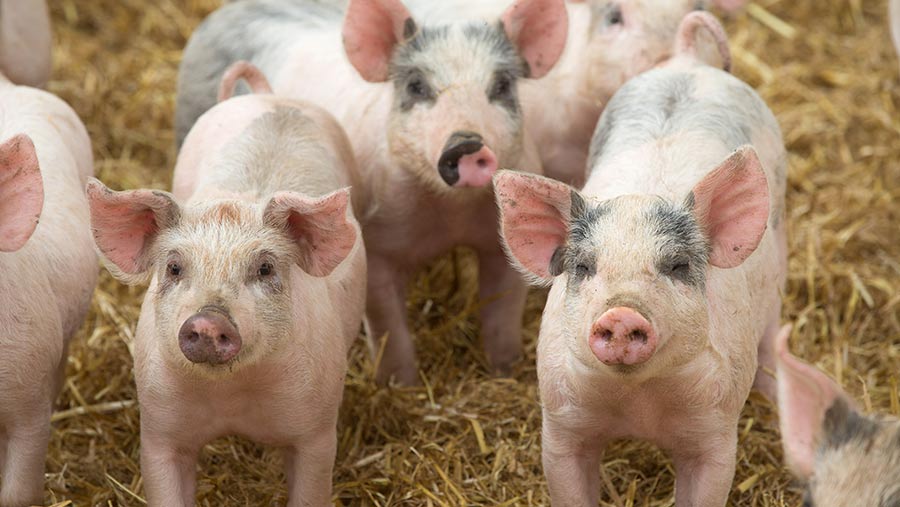Pig losses grow as production costs rise
 © Tim Scrivener
© Tim Scrivener Pig producer losses are mounting as prices sink further below the average cost of production, AHDB figures show.
The sector board’s latest Pig Market Weekly shows that the EU-spec Standard Pigs Price (SPP) fell by 0.49p to 146.30p/kg during the week ending 13 October.
This puts current prices 11.59p lower than in the same week last year.
According to AHDB lead analyst Duncan Wyatt, average production costs are 150p/kg dw and have been running at a four-year high during 2018, so at SPP levels producers are losing about £3 a head.
See also: Pressure on pork profits pushing out pig producers
Mr Wyatt said 150p/kg was a fully costed figure and included elements such as depreciation, buildings, labour, feed, energy and bedding.
Much of the rise in costs has been a result of increases in feed prices, which were 9p/kg higher during April to June this year compared with the same period in 2017.
Negative margins
AHDB Pork analyst Bethan Wilkins said that even though feed costs reflected spot prices and many producers would have bought cheaper forward stocks, large numbers of farms were looking at negative margins.
“At the end of Q2 we estimated profit margins for finished pigs to be just 1p/kg or about £1/head,” Ms Wilkins said.
“Since then feed costs have gone up and prices have come back.”
She added that improved feed efficiency through the warmer, summer months might have offset some loss.
Pig numbers
The AHDB’s weekly bulletin also highlighted Defra’s June Agricultural Survey figures, which reported a rise in the UK pig herd of 1% year-on-year to 5m head.
The increase was mainly as a result of a 2% rise in England, while declines were recorded in Northern Ireland (-2%) and Scotland (-3%).
However, the AHDB has urged caution on using the census figures as an indication of trends in pig numbers.
The overall herd increase was driven by a rise in feeding pigs to 4.5m head – a 1% increase compared with 2017, the Defra figures showed.
Clean pig slaughtering figures between July and September 2018 show a slightly higher rise, with 57,400 (2%) more pigs killed than in the same three months last year.
This indicates there were more pigs on the ground than the census figures suggests, Ms Wilkins explained.
Trends from the June survey are typically not supported by subsequent slaughtering data, so this year’s results should be treated with caution, she added.
Ms Wilkins also suggested the official figures for a declining breeding herd did not reflect the true picture. The UK breeding herd showed a 1% decline to 504,000 head.
Within this, the active female breeding herd recorded a similar decline, to 410,000 head.
Higher pig feed production
“But production of compound breeding feed was 3% higher than a year earlier between May and July this year, pointing to the fact that there were more mouths to feed on farms – not fewer, as Defra says,” Ms Wilkins said.
“While there is some uncertainty, the AHDB believes that a small increase in the breeding herd may be have been a more feasible situation over the past 12 months.
“Therefore, with feed efficiency improving recently and productivity gains anticipated in general, the supply of UK clean pigs for slaughter is expected to continue rising in the coming year.”
Further increases in pig numbers may be seen as the UK gears up for Brexit.
“Some larger pig producers are anticipating a decline in imports as we leave the EU and are already increasing production to meet a potentially unfulfilled domestic demand,” Ms Wilkins said.
Pigmeat market factors
- EU pig prices have dropped sharply recently, with pork from Belgium being particularly cheap as a result of the discovery of African Swine Fever, raising the level of import pressure for the UK.
- The latest EU census shows a small fall in the number of breeding sows and an increase in slaughter pig numbers.
- EU production is forecast to grow in the latter part of 2018, and then fall in 2019 as the reduction in breeding herd size feeds through.
- The US Department of Agriculture predicts global pork production will rise by 1% in 2019, reflecting continued expansion in China and the USA, underpinned by global economic growth driving increased demand.
- World pigmeat trade prospects are, however, clouded by rising levels of African Swine Fever, in both China and the EU, alongside trade tensions.
- At 7.9 million head in the first nine months of 2018, UK clean pig slaughterings were 3% higher than in the same period of 2017.
- UK pigmeat production was up 4% at 687,300 tonnes, with carcass weights generally higher so far in 2018.
- September’s UK average carcass weights fell 1.7kg year-on-year, to 82.9kg, reflecting poor growth rates during the summer and unusually high carcass weights this time last year as more pigs were rolled.
- UK sow and boar slaughterings in September were 3% higher than in the same month of 2017, at 21,000 head. Cullings have been above year-earlier levels every month this year, except in June, partly because of lower profitability but possibly more significantly as a result of a higher replacement rate this year.
- UK pigmeat imports fell in August, while exports increased compared with a year earlier.
- So far in 2018, pork imports have been 7% below last year, at an average price that was 11% lower than a year earlier, and with an overall value of £66.5m.
- August bacon imports rose 17% year-on-year, though the value of this trade was 10% down at £40.4m.
- UK pork exports rose slightly in August, to 18,200 tonnes. Average pork export prices were lower than last year, with the value of exports down 4% at £23.1m.
